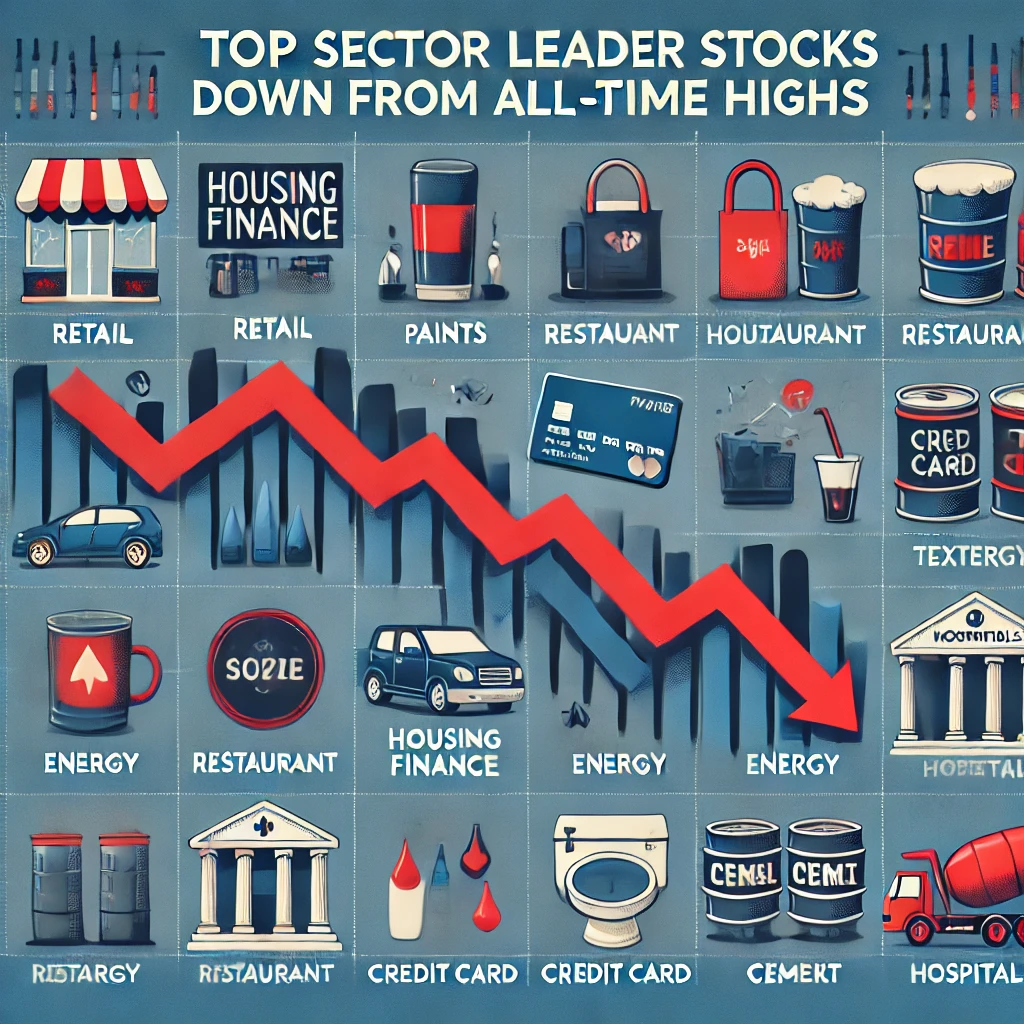When it comes to investing, even the top players face market corrections. Several sector-leading stocks have seen declines from their all-time highs (ATH) over the past year. This trend offers a unique perspective on the market’s ebb and flow and insights into potential buying opportunities.
Market Performance Overview: Q2 2024 vs. Q1 2024
The Q2 earnings season showed mixed results across sectors. While some companies reported strong revenue growth, others faced headwinds due to macroeconomic pressures, increased costs, and fluctuating consumer demand. When comparing Q2 to Q1, we observed that:
- Consumer-Focused Sectors: Retail, restaurant, and consumer goods sectors faced pressure from reduced discretionary spending.
- Industrial and Energy Sectors: Energy stocks were affected by volatile oil prices and global economic uncertainties, which dampened growth despite strong operational performance.
- Healthcare and Finance: Some healthcare and finance sectors managed steady performance, yet showed mild slowdowns, largely due to rising interest rates and increased operational costs.
In light of these factors, here’s a breakdown of some notable sector leaders and how much they’re currently down from their ATHs:
1. Retail Sector: Avenue Supermarts (-35%)
Avenue Supermarts, known for its retail chain DMart, has seen a 35% drop from its peak. Rising costs and competitive pricing challenges contributed to a softer Q2, as consumers are becoming price-sensitive amid inflation.
2. Paints Sector: Asian Paints (-31%)
Asian Paints, a key player in the paints industry, saw a 31% dip from ATH. The company faced rising raw material costs in Q2, which weighed on its margins. Q1’s performance was stronger due to better consumer sentiment, but Q2 saw some pullback.
3. Housing Finance: Bajaj Housing Finance (-31%)
Facing a similar 31% decline, Bajaj Housing Finance was impacted by rising interest rates. Despite demand for housing loans, the cost of borrowing in Q2 rose, limiting growth compared to Q1.
4. Restaurant Sector: Jubilant FoodWorks (-32%)
Jubilant FoodWorks, a leader in the restaurant sector with brands like Domino’s, faced a 32% correction. Inflation affected consumer spending on dining out, impacting Q2 results compared to a stronger Q1.
5. Beverage Sector: Tata Consumer (-24%)
Tata Consumer saw a 24% drop from ATH, impacted by increased input costs in the beverage industry. Q2 showed a mild contraction in revenue compared to Q1 as consumer spending shifted toward essential products.
6. Energy Sector: Reliance Industries (-21%)
Energy giant Reliance Industries saw a 21% drop, largely due to fluctuating crude oil prices and global economic uncertainty affecting Q2 more than Q1. Despite this, long-term growth drivers remain strong.
7. Footwear Sector: Metro Brands (-19%)
Metro Brands saw a 19% fall from its peak. The footwear sector is highly dependent on consumer sentiment, and while Q1 showed strong sales, Q2 faced slower demand.
8. Credit Card Sector: SBI Cards (-17%)
SBI Cards dropped 17% from ATH as higher interest rates and tighter consumer credit policies in Q2 impacted growth compared to Q1.
9. Textiles Sector: K.P.R. Mill (-15%)
The textile giant K.P.R. Mill fell 15%, affected by high raw material costs and global demand fluctuations. Q2’s performance was weaker than Q1 due to cost pressures.
10. Alcohol Sector: United Spirits (-13%)
Leading alcoholic beverages company United Spirits experienced a 13% dip. Despite resilient demand, Q2 performance was weaker than Q1 due to price sensitivity among consumers.
11. Cement Sector: UltraTech Cement (-11%)
UltraTech Cement is down 11% from ATH, as the sector faced higher costs and slower infrastructure projects in Q2 compared to Q1.
12. Hospital Sector: Apollo Hospitals (-9%)
Apollo Hospitals, a leader in healthcare, saw a modest 9% drop. The healthcare sector performed consistently through Q1 and Q2, though some higher costs contributed to the dip from ATH.
Key Takeaways
- Sector-Wise Variation: Consumer-centric sectors, such as retail, food, and footwear, saw notable declines due to discretionary spending cuts.
- Macroeconomic Impact: Rising interest rates and input costs weighed heavily on Q2 results, a trend not as pronounced in Q1.
- Long-Term Perspective: While these stocks are down from ATH, many still represent sectoral leadership and may present attractive entry points for long-term investors.
These downturns may offer buying opportunities for value-oriented investors, as sector leaders often rebound with the economy. Always consider individual financial goals, consult with professionals, and assess the risks before making investment decisions.
